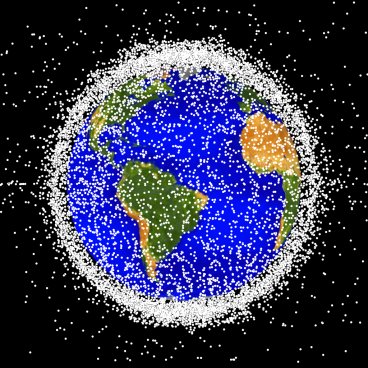
Tim Mack
Submitted by Tim Mack on
While space is too vast to imagine, and there are few who are actually capable of littering there, the orbital space surrounding our own planet is considerably smaller. In recent years, the number of launches and functional objects in low Earth orbit (LEO) have increased dramatically, and the amount of orbital trash from a variety of sources has grown at an even greater rate. Meanwhile, strategies to deal with potential problems in this arena are still problematic.
The crash of a Chinese rocket launched in 2014 into the far side of the Moon was not a trivial event, as it weighed in at nearly forty metric tons. In addition, the China Space Station had close encounters in July and October of 2021 with Starlink satellites launched by SpaceX, thus highlighting the growing orbital presence of the private sector. In response to complaints about the management of the more than 1,500 satellites SpaceX now has in orbit, CEO Elon Musk countered, “Space is just extremely enormous and satellites are very tiny,” thus highlighting the fact that few private sector players are active participants in orbital problem solving.
Georgetown University law professor David Koplow notes that many private satellites are not very maneuverable and thus are likely to stay in orbit long beyond their functional life. Although telecommunications satellites in geosynchronous equatorial obits (GEO) are assigned stable slots by the International Telecommunications Union (ITU), most LEO satellites are traveling at close to 17,000 miles per hour with an average of 1,000 new ones being placed in LEO space annually. At the beginning of 2022, the Union of Concerned Scientists counted 4,852 live satellites and nearly 3,000 defunct ones in Earth orbit.
More concerning are the 22,000 objects over 4 inches in size tracked by the U.S. Space Surveillance Network and the more than half million smaller rocket parts, scrap, and collision debris. For example, the International Space Station (ISS) has had to adjust its orbit to avoid collisions with debris over 30 times in the past 20 years.
For science fiction fans, the David Brin novel Existence (2012) predicted the development of a space scrap recycling industry, using poly-fiber lassos, and presently startups using nets, magnets, lassos, and even a giant claw are in the works. That giant claw, called ClearSpace-1, is a project of the European Space Agency (ESA) (working from a budget of 120 million euros), scheduled to launch in 2025 to pull a 220-pound piece from a 2013 ESA launch out of orbit, thus allowing it to burn up in reentry.
However, not all reentry events are so benign, such as the Russian satellite that crash-landed in northwest Canada in 1977. It contained a nuclear reactor, thus requiring extensive cleanup, under the Convention on International Liability for Damage Caused by Space Objects. Much more complicated have been orbital anti-satellite weapon testing by China and Russia (as recently as 2021), which left debris fields numbering in the thousands of fragments, regularly threatening the crews of the ISS.
The U.S. private sector at present needs to register new satellites through the National Oceanic and Atmospheric Administration, the Federal Communication Commission (for the frequency used by that satellite), and the International Telecommunications Union (if utilizing a GEO slot). Requests for a more streamlined registration system are under consideration, but the continuing expansion of private sector launch capabilities (in response to the increasing financial rewards within that sector) and ongoing orbital weapons testing suggest the need for a more structured response to orbital space development by both governments and private enterprise. And as the World Economic Forum noted in its 2022 Global Risks Report, “increased space activity could also lead to unknown environmental impacts or raise costs of public goods such as weather-monitoring or climate change surveillance.”
Clearly this is an arena demanding more care and attention than it is currently getting. Hard-charging national governments and multinational corporations appear to be more focused on political and economic advantage than on concerns for the future viability of humankind in space and the risks and downsides emerging within that sector.
References
Jeremy Conrad, “Close Encounters: Space Debris and Liability Issues,” Washington Lawyer (May/June 2022) pp. 16-18.
NASA Orbital Debris Program Office, orbitaldebris.jsc.nasa.gov
About the Author
Timothy C. Mack is managing principal of AAI Foresight Inc. and former president of the World Future Society (2004–14). He may be reached at tcm333@gmail.com.
Image credit: NASA Orbital Debris Program Office

